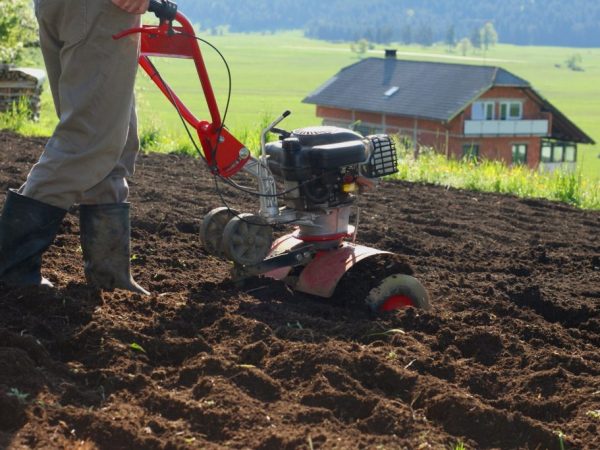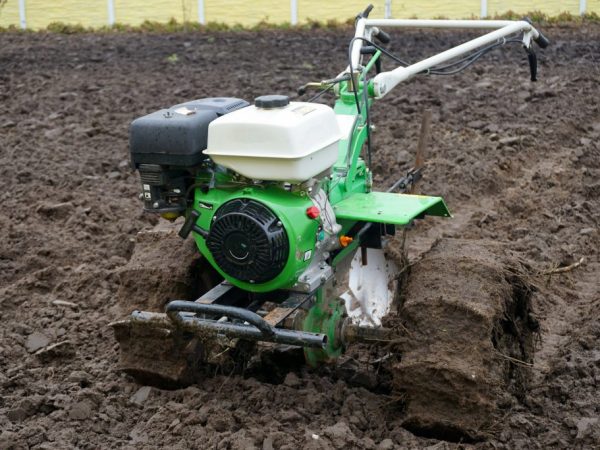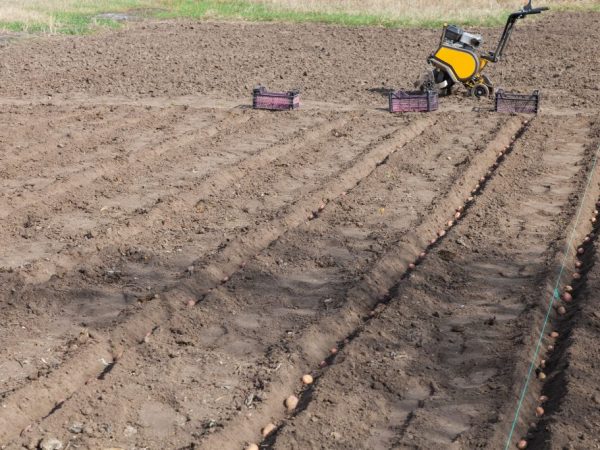Using a walk-behind tractor for growing potatoes
For any gardener, working in the garden is quite hard work. Most often, such agricultural operations as planting potatoes, hilling them, weeding potato bushes and subsequent harvesting are done by hand. However, many have adapted to use a walk-behind tractor for potatoes for these purposes, thereby reducing their labor costs and time spent in the garden.

Using a walk-behind tractor for growing potatoes
Preparatory stage
At the initial stage of soil preparation, a motoblock device for cultivating the land is used using a plow with cutters. In proper cultivation, when preparing the soil for planting potatoes, the settings for plowing are of no small importance:
- plowing and cutting of the earth is carried out at a depth of no more than the size of the bayonet of an average shovel, which is 10-12 cm,
- the passage by a motor-cultivator in width should be in the range from 0.5 to 0.6 m between rows,
- when plowing hard soil and tops, the furrow harrowing depth increases to 20-25 cm.
Most often, gardeners for plowing the land before planting potatoes use a two-body plow, mounted on a walk-behind tractor.
Requirements
- digging the soil and going through the land plot during its cultivation and loosening should be done so that one cutter of the plowman cuts the soil that has not yet been dug, and the other goes along the dug-up track, thereby improving the quality of the preparatory work performed
- to reduce the number of turns during excavation of the land, the land plot runs along the longest side,
- in the places where the walk-behind tractor turns back when plowing the land, the soil is leveled manually with a rake.
There are models of motoblock mechanisms for processing, which make it possible to dig up the earth in a circular manner. Among these are MTZ motor-cultivators. Their movement starts from the middle of the land plot and follows a spiral path. MTZ are convenient in that the operator has the opportunity to plow the land, walking when plowing next to the walk-behind tractor on the soil that has not yet been dug up.
Semi-automated method

Motoblock with hiller
Planting potatoes with a walk-behind tractor can be done in a semi-automated way with a hiller. This sowing method involves carrying out work on a small-sized planting area and requires the use of a hiller attached to a walk-behind tractor.
The purpose of the semi-automated planting method is to raise the soil, create a furrow and form earthen ridges on the sides.
Types of hillers
Hillers for semi-automated planting can be used in different ways:
- listery ordinary, in which an adjustable or fixed width of capture, outwardly they look like knives, consisting of two curved plates connected together in front and diverging behind,
- disk.
Fixed hillers
Riggers with a fixed grip are primitive and not entirely successful for planting potatoes with a walk-behind tractor. Their working grip is about 20-30 cm, which is not enough for potatoes.
Adjustable hillers
The adjustable width hiller for planting potatoes is more popular with gardeners, as it makes it possible to build the size of the land grasp by setting the preferred distance between the rows. We must not forget that its design requires the use of a stronger motoblock mechanism weighing from 30 kg and a power of 4 hp or more. The disadvantages of its use include high fuel consumption and reduced productivity, because part of the soil from the ridge crumbles back into the furrows.
Disc hillers
Disk - the more productive design of all of the above, however, is not cheap. Externally, the disc hiller looks like a flat platform of crossbars with attached discs rotating when moving. With such a device, it is possible to adjust the inter-disc distance and the angle of inclination, it is less energy-consuming and more convenient to use, it is able to form even earthen ridges of sufficient height.
Landing technology
Regardless of which type of hiller you prefer when planting potatoes, the technology includes several operations:
- initially, a hinged structure for hilling is attached to the motoblock device, lug wheels are attached, if the hiller allows, the minimum width of the soil is adjusted,
- furrows are formed into which we manually sow potatoes,
- lug wheels are replaced with simple rubberized ones; in adjustable designs, the working width is set to the maximum,
- with the help of a motor-block device, the furrows with the planted potatoes are covered with soil.
Automated way

The process is faster with a potato planter
With the automated method of planting potatoes, all operations are carried out by technology, and this involves the use of a mounted potato planter intended for this. A standard potato planter includes a number of structural elements:
- the furrow line, which is responsible for the formation of a track in the ground,
- the hopper where the seed is placed,
- stacking mechanism,
- a disc hiller used to backfill a rut with planted potatoes.
The automated method of planting potatoes with a walk-behind tractor equipped with a potato planter makes it possible to cope with the process in just one pass, saving time, fuel and energy.
Landing under the plow
In addition to the semi-automated and automated methods of planting potatoes, you can use the planting method under the plow.
In the absence of the opportunity to purchase expensive devices, many gardeners use a simple planting of potatoes with a walk-behind tractor under the plow. It differs from the above in that:
- a home-made plow with cutters is often used as a hinged device,
- forms a furrow where the seed potatoes are immediately folded by hand,
- after the reversal, a new ridge is formed, simultaneously filling the previous one.
For the convenience of this method of planting under the plow, sometimes gardeners mark the sown area with a rope, pulling it at the required distance. This is done in order to maintain the same distance between the furrows.
Care and harvesting
The motoblock device acts as a reliable assistant not only when planting, but also in the process of caring for potato bushes and harvesting the grown crop.
Hilling
The hilling procedure, which involves sprinkling the bushes with loose soil, contributes to the better development of the potato crop. Such events are done by gardeners 2-3 times a season:
- initially, with a bush height of 15 cm, this stage occurs in the second half of May,
- the secondary hilling technique is carried out at a bush height of 20-25 cm, or 2 weeks after the initial procedure,
- the third time, many do hilling after 14 days in order to add higher soil.
If you follow the experienced authors of the recommendations, the use of a walk-behind tractor for hilling is advisable at the initial stage, in order to mow the grown bushes in subsequent times and not damage the potato tubers.
Rules for hilling with a walk-behind tractor
Hilling with a walk-behind tractor involves a number of activities:
- installation of the hiller and setting the angle of rotation and depth of immersion in the ground,
- replacement of lug wheels with rubberized ones,
- the location of the walk-behind tractor with a nozzle in the center between the rows,
- movement at no speed.
Cleaning
Digging out potato tubers during harvesting with a walk-behind tractor is carried out with a potato digger specially designed for digging when replacing a hiller that is not suitable for these purposes. It looks like a hiller outwardly, but its solid surface is replaced by a rod grate.
The fan potato digger is convenient in that the digger goes deep into the ground, lifts the soil together with root crops that remain on the rods, and the earth crumbles.
The efficiency of harvesting, if you dig up potatoes with a walk-behind tractor, depends on the depth of immersion of the potato digger and can be up to 90%. Gardeners with experience have adapted to dig potatoes with a walk-behind tractor, lowering the structure no deeper than the location of the root crops. To save potato tubers from getting under the walk-behind tractor, preventing them from mechanical damage by walk-behind tractor wheels, allows digging through a row.


